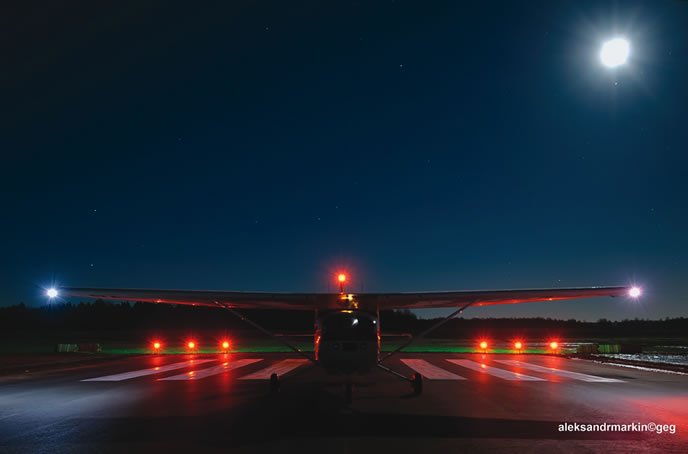Night flying can be the most rewarding kind available to mere mortals. Twinkling stars above, perhaps a full moon in close formation, and well-lit ground features can be wondrous. Too, the air generally is smoother and there’s less traffic. The frequency is quieter and ATC can give you more attention, while what traffic there is can be easier to spot. And an aircraft will perform better in cooler air. Humans will, too, but that’s about the only benefit we realize at night.
In fact, our eyes play tricks on us at night. And there’s the simple fact that it’s dark out, and darkness tends to hide various objects from us, like poor weather, mountain ridges and other things we don’t want to fly into. Understanding how the human eye is affected when it’s dark and then compensating for the condition, plus adopting some common-sense practices for avoiding things that we can bump into at night, will help make our flying easier, safer and more enjoyable.
The Eyes Don’t Have It
Perhaps our prehistoric forebears enjoyed a night-vision capability evolution has discarded. How else to explain human survival against predators with low-light vision far superior to ours? Until we learned to harness fire, nightfall likely meant huddling in a cave, waiting for sunrise. But human evolution is fickle, and instead of evolving better night vision, we developed ways to illuminate our surroundings. Today, we’re stuck with the results.
So we compensate, and understanding the limitations of human night vision can help keep us out of the darkened weeds. One thing on which we may need a refresher is understanding how the human eye’s structure makes night vision problematic.

The light receptors in them—the so-called rods and cones—are optimized for different tasks. Cones excel at differentiating color and fine details at high light levels. Rods, on the other hand, are very sensitive at low light levels. Both are distributed throughout the eye’s retina, which is where light entering the eye is converted to nerve impulses, but the cones are concentrated in the fovea, that part of the eye comprising the center of our vision field, where most of the actual “seeing” takes place. Relatively few rods are located in the fovea, but they’re more numerous elsewhere in the retina. Thankfully, there are a few ways we can compensate for the rods’ superiority in low-light situations and their distribution throughout the retina.
Compensation
One way to compensate is to minimize bright light and allow the eyes time to adapt itself to the low-light situation. Yes, it’s obvious, but many of us forget we can’t divert our eyes from a bright cockpit to a dark sky and expect to see anything that’s not already illuminated. We can begin adapting before we even start the engine by turning down cockpit illumination to the bare minimum. As the flight progresses and our eyes continue adapting, cockpit lighting can be turned down even further, perhaps to its minimum setting.
If we need to use additional cockpit lighting to find the right control or read a map, there’s a way we can have the cake of decent night vision but also eat the slice of viewing the hidden object we’re looking for: close one eye before turning up the lights. Once our need for brighter cockpit illumination passes and the lights have been turned back down, open the “dark” eye and close the “bright” eye to accelerate its adaptation.
Another way to compensate is to continue scanning the dark sky just as we would in daytime. To effectively scan for traffic in daylight, we need to keep our head and eyes moving—on a swivel, as the old saying goes. Thanks to the rod placement in our retina, if we were scanning for obstacles at night, we won’t find them by looking directly at illuminated objects. Instead, we should look to the side or above/below what we’re trying to see, and allow the rods to gather as much of the dim light as they can. Remember: Not everything we may want to avoid at night is illuminated.
Avoiding NIGHT CFIT
Which brings us to night flying’s other principal challenge: avoiding collisions with unseen objects. The sidebar above includes suggestions about choosing a nighttime cruising altitude but leaves us unfulfilled when in terminal areas near airports. Instrument charts provide a partial solution, again, by depicting lit and unlit objects—radio towers, buildings and high terrain—near an airport. They also depict minimum safe altitudes in all quadrants near the airport and suggest how high you should be at various distances from the facility, i.e., when on an approach.
Carrying instrument charts was a burden for VFR-only pilots until electronic charting became the standard. These days, it’s likely the subscription to your electronic flight bag of choice includes IFR and VFR products for the same price, so there’s no real excuse for not using them, except perhaps familiarity. That’s easily overcome with a brief examination of the various legends. A quick study of the appropriate terminal charts for obstacles and approach/departure paths before your VFR night flight will highlight what to look for and when you can safely descend from cruising altitude without hitting anything.
Understanding how terrain and obstacles are charted, plus the human eye’s limitations in low light, can help make your night flying just as safe as in the daytime. Remember your flashlight.



